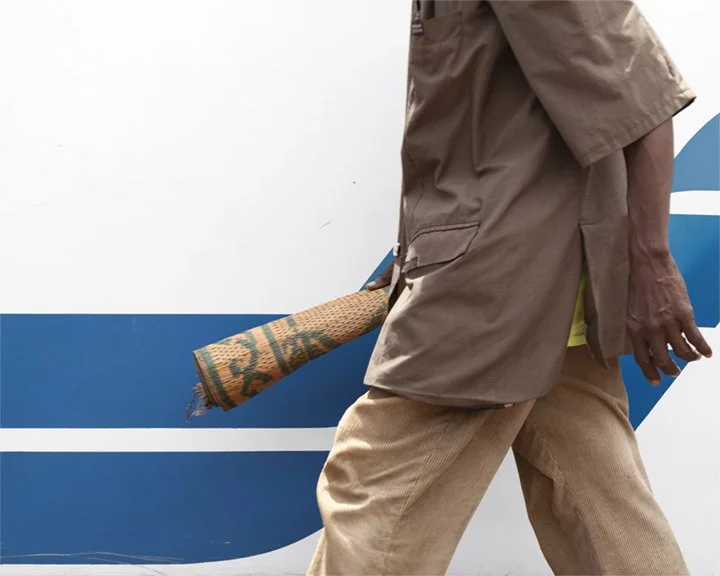
Untitled (Distance) Cap Spartel, Morocco, Archival pigment print, 40 x 50 inches, 2016
The Stranger's Notebook encompasses a sprawling journey across Africa and Europe. The multidisciplinary project – photography, moving image, objects, and sound – draws from work made during a thirteen-month road trip from Nigeria to Morocco to Southern Europe between 2014 and 2015. The series includes works made in cities like Bamako in Mali, Nouakchott in Mauritania, Dakar in Senegal, and Catania in Sicily. The project's title makes reference to the French philosopher Albert Camus' novel L'Etranger (1942), and how Camus understands and communicates "the experience of outsiderness". The Stranger's Notebook also draws upon the German sociologist Georg Simmel's ideas of the 'paradoxical stranger'. "If wandering is the liberation from every given point in space, and thus the conceptional opposite to fixation at such a point, the sociological form of the "stranger" presents the unity, as it were, of these two characteristics," Simmel wrote in his seminal essay. However, it is Fesseha Giyorgis, an Abyssinian cultural figure widely regarded as the father of Tigrinya literature, who formed the basis of the project's framework. Giyorgis wrote a travelogue, "About the Author's Journey from Ethiopia to Italy and the Impressions Made on Him by His Stay in That Country in Tigrinya" (1895), in which he chronicles his travels from Massawa, on the Red Sea coast, to Italy, where he lived and worked for five years. Giyorgis' text provides a counterpoint to contemporary narratives of migration and challenges the legacy of European colonialism against which these narratives continue to unfold. The Stranger's Notebook: attempts to synthesize these texts to examine the complexity of migratory movements within Africa, questioning the privileging of certain narratives of migration over others.

(Detail) A series of complicated ambivalences, Bamako, Mali Archival color pigment prints, 20 x 25 inches, 2016
Untitled (Distance) Cap Spartel, Morocco, Archival pigment print, 40 x 50 inches, 2016
The Stranger's Notebook encompasses a sprawling journey across Africa and Europe. The multidisciplinary project – photography, moving image, objects, and sound – draws from work made during a thirteen-month road trip from Nigeria to Morocco to Southern Europe between 2014 and 2015. The series includes works made in cities like Bamako in Mali, Nouakchott in Mauritania, Dakar in Senegal, and Catania in Sicily. The project's title makes reference to the French philosopher Albert Camus' novel L'Etranger (1942), and how Camus understands and communicates "the experience of outsiderness". The Stranger's Notebook also draws upon the German sociologist Georg Simmel's ideas of the 'paradoxical stranger'. "If wandering is the liberation from every given point in space, and thus the conceptional opposite to fixation at such a point, the sociological form of the "stranger" presents the unity, as it were, of these two characteristics," Simmel wrote in his seminal essay. However, it is Fesseha Giyorgis, an Abyssinian cultural figure widely regarded as the father of Tigrinya literature, who formed the basis of the project's framework. Giyorgis wrote a travelogue, "About the Author's Journey from Ethiopia to Italy and the Impressions Made on Him by His Stay in That Country in Tigrinya" (1895), in which he chronicles his travels from Massawa, on the Red Sea coast, to Italy, where he lived and worked for five years. Giyorgis' text provides a counterpoint to contemporary narratives of migration and challenges the legacy of European colonialism against which these narratives continue to unfold. The Stranger's Notebook: attempts to synthesize these texts to examine the complexity of migratory movements within Africa, questioning the privileging of certain narratives of migration over others.
(Detail) A series of complicated ambivalences, Bamako, Mali Archival color pigment prints, 20 x 25 inches, 2016

